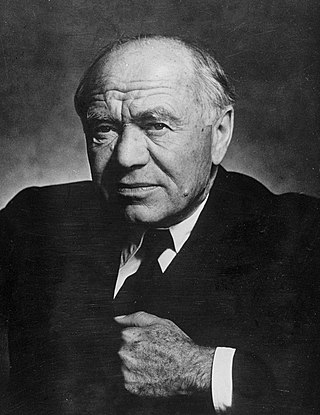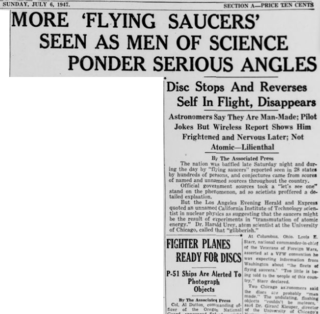
The Sunday Dispatch was a prominent British newspaper, published between 27 September 1801 and 18 June 1961. [1] [2] It was ultimately discontinued due to its merger with the Sunday Express. [3]

The Sunday Dispatch was a prominent British newspaper, published between 27 September 1801 and 18 June 1961. [1] [2] It was ultimately discontinued due to its merger with the Sunday Express. [3]
The newspaper was first published as the Weekly Dispatch in 1801, and was owned in the mid-1800s by notable solicitor James Harmer, who served as a model for Jaggers, the Charles Dickens character from Great Expectations . [4] The newspaper's name was changed to the Sunday Dispatch in 1928.
In 1903, the Newnes family sold the paper to Alfred and Harold Harmsworth. The new owners then turned it around from bankruptcy and into the biggest selling Sunday newspaper in Britain at the time. [ citation needed ]
Due to editor Charles Eade's role as Press Liaison officer for Lord Mountbatten during World War II, distribution of the Dispatch was up from 800,000 to over 2 million copies per edition in 1947. [5]
In 1959, Eade and the editor of the Daily Sketch were fired due to a comment from Randolph Churchill that Esmond Harmsworth, 2nd Viscount Rothermere, was "pornographer royal" for his ownership of both the Daily Sketch and Sunday Dispatch. [6]
Under its last editor, Walter Hayes, the Dispatch still maintained pre-printed posters with the headline "CHURCHILL IS DEAD", in preparation of the death of Randolph Churchill's father Winston Churchill. [7]
In December 1960, the paper had a respectable circulation of 1,500,000 copies. Despite this, the Sunday Dispatch was merged with the Sunday Express in 1961. [8] [9]
The Dispatch is prominently featured in Philip Norman's 1996 novel Everyone's Gone to the Moon. The novel is centred on the reporting of the British pop invasion of America in the 1960s. [10]

William Maxwell Aitken, 1st Baron Beaverbrook, generally known as Lord Beaverbrook, was a Canadian-British newspaper publisher and backstage politician who was an influential figure in British media and politics of the first half of the 20th century. His base of power was the largest circulation newspaper in the world, the Daily Express, which appealed to the conservative working class with intensely patriotic news and editorials. During the Second World War, he played a major role in mobilising industrial resources as Winston Churchill's Minister of Aircraft Production.

The Daily Mail is a British daily middle-market tabloid newspaper published in London. It was founded in 1896. As of 2020, it was the highest paid circulation newspaper in the UK. Its sister paper The Mail on Sunday was launched in 1982, a Scottish edition was launched in 1947, and an Irish edition in 2006. Content from the paper appears on the MailOnline news website, although the website is managed separately and has its own editor.
Kenneth Albert Arnold was an American aviator, businessman, and politician.
In ufology, the psychosocial hypothesis, abbreviated PSH, argues that at least some UFO reports are best explained by psychological or social means. It is often contrasted with the better-known extraterrestrial hypothesis (ETH), and is particularly popular among UFO researchers in the United Kingdom, such as David Clarke, Hilary Evans, the editors of Magonia magazine, and many of the contributors to Fortean Times magazine. It has also been popular in France since the publication in 1977 of a book written by Michel Monnerie, Et si les ovnis n'existaient pas?.
A UFO religion is any religion in which the existence of extraterrestrial (ET) entities operating unidentified flying objects (UFOs) is an element of belief. Typically, adherents of such religions believe the ETs to be interested in the welfare of humanity which either already is, or eventually will become, part of a pre-existing ET civilization. Other religions predate the UFO era of the mid 20th century, but incorporate ETs into a more supernatural worldview in which the UFO occupants are more akin to angels than physical aliens, but this distinction may be blurred within the overall subculture. These religions have their roots in the tropes of early science fiction and weird fiction writings, in ufology, and in the subculture of UFO sightings and alien abduction stories. Historians have considered the Aetherius Society, founded by George King, to be the first UFO religion.

Cecil Harmsworth King was Chairman of Daily Mirror Newspapers, Sunday Pictorial Newspapers, and the International Publishing Corporation (1963–1968), and a director at the Bank of England (1965–1968).
This is a list of notable alleged sightings of unidentified flying objects (UFOs) in the United Kingdom. Many more sightings have become known since the gradual release, between 2008 and 2013, of the Ministry of Defence's UFO sighting reports by the National Archives. In recent years, there have been many sightings of groups of slowly moving lights in the night sky, which can be easily explained as Chinese lanterns. Undertaken between 1997 and 2000, Project Condign concluded that all the investigated sightings of unidentified aerial phenomena in the UK could be attributed to misidentified but explicable objects, or poorly understood natural phenomena.

From July 12 to 29, 1952, a series of unidentified flying object (UFO) sightings were reported in Washington, D.C., and later became known as the Washington flap, the Washington National Airport Sightings, or the Invasion of Washington. The most publicized sightings took place on consecutive weekends, July 19–20 and July 26–27. UFO historian Curtis Peebles called the incident "the climax of the 1952 (UFO) flap"—"Never before or after did Project Blue Book and the Air Force undergo such a tidal wave of (UFO) reports."

A flying saucer, also referred to as a flying disc, is a descriptive term for a type of flying craft having a disc or saucer-shaped body, commonly used generically to refer to an anomalous flying object. The term was coined in 1947 but has generally been supplanted since 1952 by the United States Air Force term unidentified flying objects, UFOs for short. Early reported sightings of unknown "flying saucers" usually described them as silver or metallic, sometimes reported as covered with navigation lights or surrounded with a glowing light, hovering or moving rapidly, either alone or in tight formations with other similar craft, and exhibiting high maneuverability.

Winston Churchill, in addition to his careers as a soldier and politician, was a prolific writer under the variant of his full name 'Winston S. Churchill'. After being commissioned into the 4th Queen's Own Hussars in 1895, Churchill gained permission to observe the Cuban War of Independence, and sent war reports to The Daily Graphic. He continued his war journalism in British India, at the Siege of Malakand, then in the Sudan during the Mahdist War and in southern Africa during the Second Boer War.

Hugo Francis Guy Charteris MC was a noted British novelist and screenwriter, the author of nine novels, 17 television screenplays and numerous children's books and short stories.

The Kenneth Arnold UFO sighting occurred on June 24, 1947, when private pilot Kenneth Arnold claimed that he saw a string of nine, shiny unidentified flying objects flying past Mount Rainier at speeds that Arnold estimated at a minimum of 1,200 miles an hour (1,932 km/h). This was the first post-World War II sighting in the United States that garnered nationwide news coverage and is credited with being the first of the modern era of UFO sightings, including numerous reported sightings over the next two to three weeks. Arnold's description of the objects also led to the press quickly coining the terms flying saucer and flying disc as popular descriptive terms for UFOs.
Charles Eade was a British newspaper editor.
David William Clarke is an investigative journalist, reader and lecturer at Sheffield Hallam University, England. He has a lifelong interest in folklore, Fortean phenomena and extraordinary personal experiences. He is frequently consulted by the national and international media on contemporary legend and UFOs and acted as curator for The National Archives UFO project from 2008 to 2013.

Ann Geraldine Mary Fleming was a British aristocrat and socialite. She married Lord O'Neill, Lord Rothermere and finally the writer Ian Fleming.

The Flight 105 UFO sighting occurred on July 4, 1947, when three crew members aboard a United Airlines flight reported seeing multiple unidentified flying objects in the skies over the Pacific Northwest. The incident was among at least 800 similar sightings in the United States within a few weeks in the summer of 1947, but the first report by professional pilots. The U.S. military ultimately attributed what the crew members saw to "ordinary aircraft, balloons, birds, or pure illusion".

The 1947 flying disc craze was a rash of unidentified flying object reports in the United States that were publicized during the summer of 1947. The craze began on June 24, when media nationwide reported civilian pilot Kenneth Arnold's story of witnessing disc-shaped objects which headline writers dubbed "Flying Saucers". Such reports quickly spread throughout the United States; historians would later chronicle at least 800 "copycat" reports in subsequent weeks, while other sources estimate the reports may have numbered in the thousands.

The Rhodes UFO photographs, sometimes called the shoe-heel UFO photographs, purport to show a disc-like object flying above Phoenix, Arizona, United States. The two photographs were reportedly taken on July 7, 1947, by amateur astronomer and inventor William Albert Rhodes. They were printed in The Arizona Republic newspaper on July 9, along with Rhodes's account of his sighting of the object. Published near the end of the 1947 flying disc craze, the photographs were among the first showing an unidentified flying object. They continue to be discussed in the media into the 21st century.

The Report on Unidentified Flying Objects is a 1956 book by then-retired Air Force UFO investigator Edward J. Ruppelt, detailing his experience running Project Bluebook. The book was noted for its suggestion that a few UFO sightings might be linked to spikes of atomic radiation. Contemporary media summarized four topics discussed in the book: